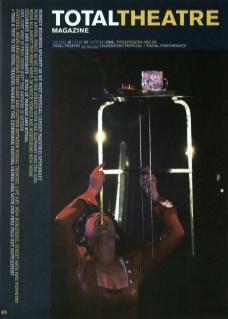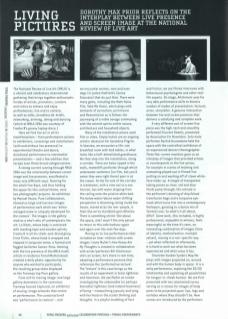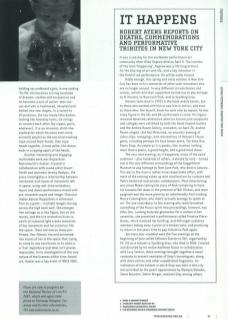The National Review of Live Art (NRLA) is a vibrant and celebratory international gathering that brings together enthusiastic hordes of artists, promoters, curators and critics to witness and enjoy performances, live and to camera, as well as talks, breakfast de-briefs, networking, drinking, dining and dancing (which at NRLA 2006 was courtesy of Franko B's groovy laptop disco).
Here we find live art in all its manifestations – from performance actions to exhibitions, screenings and installations (with and without live presence) to experimental theatre and dance, durational performance to intermedial presentations – and a few oddities that escape even these broad categorisations.
A strong current running through NRLA 2006 was the relationship between screen image and live presence, manifested in many very different ways. Running for the whole five days, and thus holding the space for this central theme, were two photographic projects. An exhibition by Manuel Vason, Pure Collaboration, showed us large and luscious images of performance work which was 'either restaged anew or uniquely developed for the camera'. The images in the gallery read as a who's who of contemporary live art: La Ribot, whose body is sectioned with masking tape and wooden splints; Franko B in all his chalk-and-blood glory; Ernst Fisher, whose head is wrapped and mapped in turquoise twine; a fanned and fagged Guillermo Gomez-Pena. Working with the live presence of the NRLA itself, artists in residence French Mottershead created a daily photo-opportunity for anyone who wanted to participate, the resulting group shots displayed on the Tramway top floor gallery.
From still to moving image: one large gallery downstairs in the cavernous Tramway housed Captured, an exhibition of moving-image artworks that centre on performance. The curatorial brief was 'performance to camera' – and we encounter women, men and even dogs (in Jackie Hatfield's Canine Staccato) that do just that. There were many gems, including the Matt Hulse film, Take Me Home, which plays with elements of surrealism, primitivism and Romanticism as it follows the journeying of a noble savage communing with the animist spirits within nature, architecture and household objects.
Many of the installation pieces used film or video. Empty hotels are an ongoing artistic obsession for Geraldine Pilgrim. In Seaview, we encounter a life-size breakfast room with laid tables, in what looks like a half-demolished guesthouse. We then step into the installation, along a corridor. There are holes ripped in the walls, makeshift portholes through which underwater swimmers (on film, but you'd swear they were right there) peer in at the viewer. At the far end of the corridor is a bedroom, with a view out to a sea horizon, but with water dripping from the ceiling onto the pristine white bed. The below water / above water shifting perspective is disarming; being inside the house, stared at by the mer-people, it feels like we've stumbled upon Atlantis. There is something shrine-like about the space, and I wasn't the only person to return to this safe harbour again and again over the next few days.
Moving on to live performances that included an interrelation with screen images: Ivana Muller's How Heavy Are My Thoughts is created in collaboration with writer/performer Bill Aitchinson: she's on screen, he's there in real time, adopting a performance persona that references the ‘performative lecture'. The 'lecture in this case brings us the results of an experiment in brain lightness and heaviness. We see Muller on screen investigating the unbearable (or perhaps bearable) lightness (and indeed heaviness) of being – trampolining joyously and lying with her head on the scales thinking sad thoughts. In a playful muddling of fact and fiction, we see filmed interviews with behavioural psychologists and other real-life experts. On stage, Aitchinson uses his very able performance skills to blend a number of modes of presentation: lecturer, actor, storyteller. A genuine interaction between live and screen presence that delivers a satisfying and complete work.
A very different sort of screen/live piece was the high-tech and smoothly performed Discreet Deaths, presented by Association Fin Novembre. Solo male performer Rachid Ouramdane held the space with the controlled confidence of an experienced dancer/choreographer. Three flat-screen monitors gave us an interplay of images that provided echoes or counterpoints to the live action, for example in scenes of masking and unmasking played out in filmed/live putting on and washing off of clown whiteface make-up. A tangle of transparent tubing pulses as clear, red and blue fluids pump through; this echoed in the performer's donning of drip/blood transfusion bags and a turquoise eyemask which turns him into a contemporary Harlequin, gyrating to a dance mix of Tainted Love. So what's it all about, Alfie? Some work, this included, is highly professional, enjoyable to witness, feels meaningful at the time it's seen, an interesting combination of images (here of identity, medicalisation, multiple selves), moving in a non-specific way – yet when reflected on afterwards, it is hard to work out what has been experienced and what value it has.
Charlotte Vanden Eynde's Map Me plays with images projected on, around and with the human body in space. It is a witty performance, exploring the 2D/3D realtionship and exploiting all possibilities for tongue-in-cheek humour. We are first presented with two intertwined torsos serving as a canvas for images of body parts to be projected upon: lips, legs and earlobes where they shouldn't be. New scenes are introduced by the performers holding up cardboard signs; in one stating 'Fix Me' she becomes a living wardrobe of drawers, clothes and accessories and he becomes a sort of action-man cutout doll who is hammered, chiselled and bolted into new shapes. In a switch to 3D presence, the two lovely lithe bodies, looking like heavenly twins, tie strings to connect each other (by nipple, penis, whatever). It is an innocent, child-like exploration which becomes even more surreally playful as the two wind masking tape around their heads, then tape heads together. A mad polka-like dance ends in a ripping apart of the heads.
Another interesting and engaging multimedia work was Rajyashree Ramamurthi's Avatar. Created in collaboration with sound artist Stuart Smith and animator Jeremy Radvan, the piece investigates a relationship between movement and traces of movement left in space, using real-time animation, music and dance performance mixed with pre-recorded sound and image. Classical Indian dancer Rajyashree is witnessed first as a giant – multiple images moving across the high back wall. She emerges live onstage as a tiny figure, but as she moves, and the live animation kicks in, swirls of coloured light create memories of her movement and her presence fills the space. There are now so many pre-filmed, live-filmed, live and animated live traces of her in the space that trying to come to any conclusion as to what is a 'live' experience and what isn't proves impossible. In its investigation of the very nature of the liveness within time-based art, Avatar was a key event of NRLA 2006.
Plans are now in progress for the National Review of Live Art 2007, which will again take place at Tramway Glasgow. For dates and further information, See www.newterritories.co.uk
It Happens – Robert Ayers reports on deaths, commemorations and performative tributes in New York City
It was a sad day for the worldwide performance art community when Allan Kaprow died on April 5. The inventor of the term ‘happening', Kaprow was a life long activist for the blurring of art and life, and a key innovator in the field of art performance. He will be sadly missed.
Oddly enough, this spring and early summer in New York City has been rich in memories of other such innovators who are no longer around. In very different circumstances and venues, artists and their supporters turned out to pay homage to Al Hansen, to Nam June Paik, and to Spalding Gray.
Hansen (who died in 1995) is the least widely known, but to those who worked with him or saw him in action, and even to those who, like myself, know his work only by repute, he was a key figure in the 50s and 60s performance scene. His legacy received deserved celebration when his bizarre junk sculptures and collages were exhibited by both the Pavel Zoubok Gallery and the Andrea Rosen Gallery, and when, on April 24, Andrea Rosen staged 3rd Rail Revisited, an anarchic evening of video clips, restagings, and reinventions of Hansen's Fluxus gems, including perhaps his best known piece, The Yoko Ono Piano Drop. As simple as it is poetic, this involves nothing more than a piano, a great height, and a good hard shove.
The very next evening, as it happened, many of the same audience – plus hundreds of others, it should be said – turned out in the very different surroundings of the Guggenheim Museum to pay homage to Nam June Paik, who died in January. This was in the main a rather more respectable affair, with most of the evening taken up with recollections by curators and Paik's technical and artistic collaborators. Most entertaining was Jonas Mekas telling the story of Paik conspiring to have his trousers fall down in the presence of Bill Clinton, and most poignant was the wave given by an unbelievably frail-looking Merce Cunningham, who didn't actually manage to speak at all. The one contributor to the evening who really breathed something of the Fluxus spirit into proceedings, however, was Yoko Ono. Looking bizarrely glamorous for a woman in her seventies, she presented a performance called Promise PieceBones, which involved her knitting, and 450 eager audience members taking away a piece of a broken vase, and promising to return in ten years time to pay tribute to Paik again.
Yet more star-studded were the five evenings at the beginning of June called Leftover Stories to Tell, organised by PS 122 as a tribute to Spalding Gray, who died in 2004. Created and directed by his widow Kathleen Russo in collaboration with Lucy Sexton, these evenings brought together a small company to present examples of Gray's monologues, along with diary entries and other unpublished fragments. An indication of the esteem in which Gray was held in this city was provided by the guest appearances by Olympia Dukakis, Steve Buscemi, Debra Winger, and Joel Grey among others.


